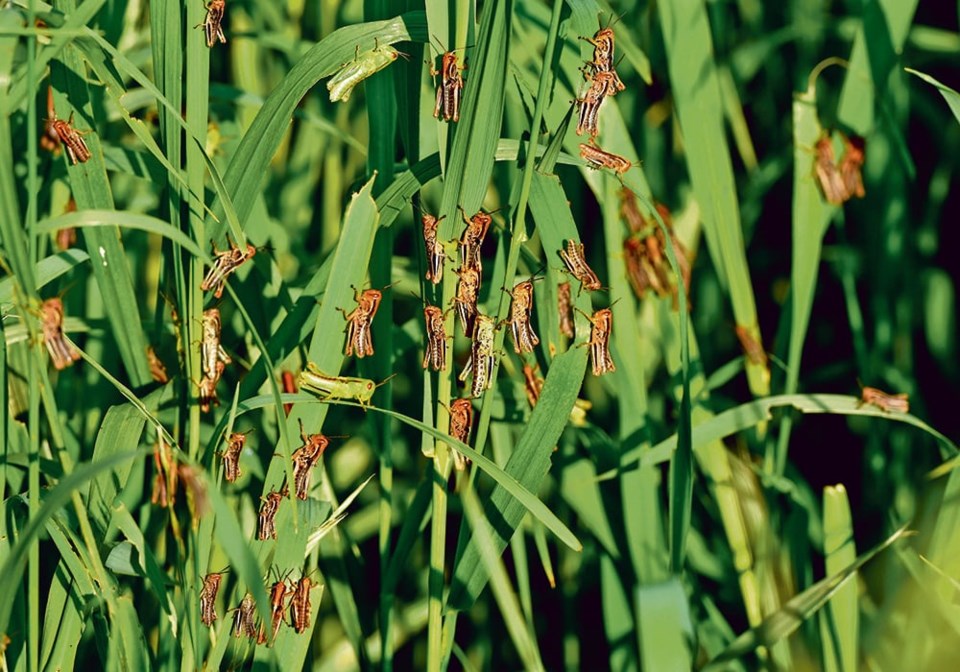WESTERN PRODUCER — The early heat this year has pushed grasshopper development ahead of schedule.
Reports have come in particularly from Saskatchewan and Alberta of rapid hatch and growth but the Prairie Pest Monitoring Network map shows all three prairie provinces were experiencing the same thing.
Farmers are urged to make sure they are dealing with a pest variety of hopper before they decide to spray.
“The good news is if you have millions you don’t have to know (which species),” said Dan Johnson from the University of Lethbridge. “If you have millions, they are definitely pests. None of the naturally occurring ones out on the rangeland that feed birds and participate in the ecosystem ever form millions.”
However, the main pest species, the two-striped grasshopper, has been found in large numbers.
Saskatchewan provincial pest specialist James Tansey said in a webinar earlier this month that fifth instar two-striped nymphs were appearing in south-central regions and the adults will appear well before the end of June.
That’s at least two weeks before expected.
There were also fourth instar nymphs in the Regina and Lumsden areas and other southern areas.
“They are really speeding through their development quickly,” he said.
The rapid onset of adult populations could mean more eggs going into the ground and trouble ahead for next year.
The two-striped grasshopper has become the prevalent pest species in the province, although it was the lesser migratory species that caused most of the damage in the 1930s, 1940s and 1980s.
The other main pest is the clear-winged grasshopper.
Johnson said he has heard from farmers that there are heavy pest densities in pockets.
“You’ve got to have several things to have an outbreak,” he said.
These are: grasshoppers the year before, the right weather and then continued dry weather.
“The first two things are the most important, and in some years we can have hot weather and sunny conditions and it’s dry and nothing happens, and that’s because we didn’t have them the year before laying eggs,” Johnson said.
In the last couple years, grasshoppers have been laying and the sudden heat early this year has led to the early hatch.
There are places such as southeastern Alberta where rain and cool conditions kept them from hatching.
“Guess who had real extreme heat in May? Edmonton of all things. There are hoppers popping up there by the millions and they’re at the stage they would normally be at three weeks later,” said Johnson.
Provinces conduct surveys for the maps of predicted grasshopper populations but the problem with those is that they’re done in summer when the adults are easy to count. Johnson has developed a proposal for a spring count that would more accurately reflect what’s coming in a particular year.
He said that’s also where identification of whether the grasshoppers are pest or non-pest species is key. The hoppers out early in April and May are not pests.
“The two-stripe is a fat green thing and the clear-winged is a little brown one and they’re fairly easy to tell apart, and they have different diets,” he explained.
Tansey said farmers should scout to find out which species they have and how much damage they’re really doing before taking action.
“Sometimes economic injury level and economic threshold are mistaken,” he said. “The economic injury level is that balance between the cost of control and what the grasshoppers are costing you. You want to avoid that, so you want to inflict control on them before that happens.”
He said the economic threshold is generally 80 percent of the economic injury level.
For small nymphs, the threshold in crop is 30 to 45 per sq. metre; in the ditch it’s 50 to 75 per sq. metre.
“Given the conditions this year, I would err on the low side,” he said.
For adults, it varies by crop but is generally 10 per sq. metre.
Canola and soybean are more tolerant to damage so the guideline is 14 per sq. metre. For flax in boll and lentils in flower, the tolerance level is two per sq. metre.
Tansey encouraged farmers to walk a transect of at least 50 metres by one metre wide in different parts of fields to determine populations and control measures.
Johnson said there can also be a huge grasshopper population that isn’t affecting the crop so checking for damage is important. Spraying will also kill the three or four fungi that only attack grasshoppers and are the natural predators.
“Too much spraying at the wrong time might look like it’s solving the problem at the moment but it doesn’t help in the long run,” he said. “It’s better to have that biodiversity.”
In Manitoba, provincial entomologist John Gavloski said the hatch was well underway and perhaps a little earlier than usual.
Farmers are watching infestation levels and beginning some control on field edges.
“It’s hard to single out an area right now because I’ve had people right from eastern Manitoba to western Manitoba call in and inquire,” he said.
Parts of the province were damp last year and there was evidence that natural predators were reducing grasshopper numbers.
“In some areas, we were seeing a pathogen and fungus, which is really evident because grasshoppers die clinging to the top of plants and there were some areas where we saw a lot of that,” he said.




